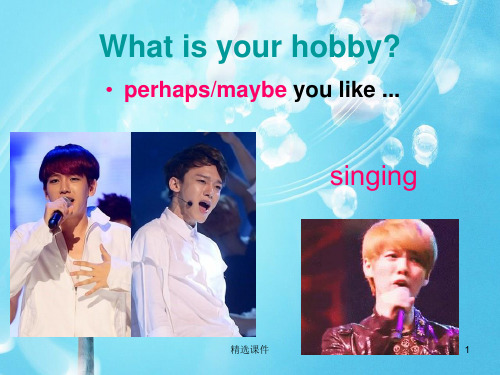初中英语语法之一般现在时趣味讲解 共18张18页PPT
合集下载
初中英语一般现在时学习课件(共25张ppt)

let?schant系动词be的一般现在时实义行为动词的一般现在时一系动词be的一般现在时1肯定句的构成
一般现在时 The simple present tense
Let's chant
Like,like, what do you like? Running, running, I like running. Like, like, what does he like? Swimming, swimming, he likes swimming. Like, like, what does she like? Fishing, fishing, she likes fishing.
二、一般现在时的构成
系动词be的一般现在时 实义(行为)动词的一 般现在时
• (一)、系动词be的一般现在时
1、肯定句的构成: 主语 + be + 其他
The girl is my friend.
2.be动词包括哪些 ?
am is are 什么时候用is? 什么时候用am? 什么时候用are?
be 的用法口诀 我用am,你用are, is连着他,她,它; 单数名词用is, 复数名词全用are。
4. He always_______(wash) clothes at 7:00.
5. They ______ (watch) TV on Sundays.
6. Miss Li_______ (teach) Chinese. 1. Look at the animal, it ____(have) four legs.
Exercise
• • • • • • • 1、Kitty ( ) an English girl. 2、We ( ) students. 3、I ( ) from Taizhou. 4、She ( ) tall. 5、Lucy and Lily ( ) good friends. 6、Those chairs ( ) broken. 7、The bag ( ) mine.
一般现在时 The simple present tense
Let's chant
Like,like, what do you like? Running, running, I like running. Like, like, what does he like? Swimming, swimming, he likes swimming. Like, like, what does she like? Fishing, fishing, she likes fishing.
二、一般现在时的构成
系动词be的一般现在时 实义(行为)动词的一 般现在时
• (一)、系动词be的一般现在时
1、肯定句的构成: 主语 + be + 其他
The girl is my friend.
2.be动词包括哪些 ?
am is are 什么时候用is? 什么时候用am? 什么时候用are?
be 的用法口诀 我用am,你用are, is连着他,她,它; 单数名词用is, 复数名词全用are。
4. He always_______(wash) clothes at 7:00.
5. They ______ (watch) TV on Sundays.
6. Miss Li_______ (teach) Chinese. 1. Look at the animal, it ____(have) four legs.
Exercise
• • • • • • • 1、Kitty ( ) an English girl. 2、We ( ) students. 3、I ( ) from Taizhou. 4、She ( ) tall. 5、Lucy and Lily ( ) good friends. 6、Those chairs ( ) broken. 7、The bag ( ) mine.
《一般现在时讲解》课件

一般现在时可以用来描述当前的情况或状态,例如“我现在很开心”、“她现在 是一名学生”等。这种时态强调的是当前的情况或状态,而不是过去或未来的变 化。
表示客观事实或普遍真理
总结词
描述不受时间影响的客观事实或普遍真理。
详细描述
一般现在时可以用来描述不受时间影响的客观事实或普遍真理,例如“地球是圆的”、“水在100摄氏度下沸腾 ”等。这种时态强调的是事实的普遍性和客观性,不会因为时间而改变。
I eat an apple every day. (我每天吃 一个苹果。)
结构
一般现在时的基本结构是“主语+谓 语+(宾语)+(其他成分)”,其中 谓语动词以原形或第三人称单数形式 出现。
一般现在时的特点
01
02
03
强调现在
一般现在时强调当前时间 点,表示动作或状态正在 发生或存在。
普遍性
一般现在时用于描述普遍 存在的真理、事实或习惯 性行为,不受时间限制。
总结词
动词形式不同
详细描述
一般现在时的动词形式为原型,而一般将 来时的动词形式需要用will+动词原型。
与现在进行时的对比
总结词
动作状态不同
详细描述
一般现在时表示现在的动作或状态,强调动作的持续性 ;而现在进行时表示正在进行的动作或状态,强调动作 的进行过程。
总结词
用法侧重不同
详细描述
一般现在时更侧重于描述习惯性、经常性的动作或状态 ,而现在进行时则侧重于描述当前正在发生的动作或状 态。
一般现在时的用法
表示习惯性或经常发生的动作
总结词
描述日常生活中的常见行为或习惯。
详细描述
一般现在时用于描述日常生活中的常见行为或习惯,例如“我每天早上起床” 、“他每周去健身房锻炼”等。这种时态强调行为的频繁性或习惯性,而不是 特定的一次性事件。
表示客观事实或普遍真理
总结词
描述不受时间影响的客观事实或普遍真理。
详细描述
一般现在时可以用来描述不受时间影响的客观事实或普遍真理,例如“地球是圆的”、“水在100摄氏度下沸腾 ”等。这种时态强调的是事实的普遍性和客观性,不会因为时间而改变。
I eat an apple every day. (我每天吃 一个苹果。)
结构
一般现在时的基本结构是“主语+谓 语+(宾语)+(其他成分)”,其中 谓语动词以原形或第三人称单数形式 出现。
一般现在时的特点
01
02
03
强调现在
一般现在时强调当前时间 点,表示动作或状态正在 发生或存在。
普遍性
一般现在时用于描述普遍 存在的真理、事实或习惯 性行为,不受时间限制。
总结词
动词形式不同
详细描述
一般现在时的动词形式为原型,而一般将 来时的动词形式需要用will+动词原型。
与现在进行时的对比
总结词
动作状态不同
详细描述
一般现在时表示现在的动作或状态,强调动作的持续性 ;而现在进行时表示正在进行的动作或状态,强调动作 的进行过程。
总结词
用法侧重不同
详细描述
一般现在时更侧重于描述习惯性、经常性的动作或状态 ,而现在进行时则侧重于描述当前正在发生的动作或状 态。
一般现在时的用法
表示习惯性或经常发生的动作
总结词
描述日常生活中的常见行为或习惯。
详细描述
一般现在时用于描述日常生活中的常见行为或习惯,例如“我每天早上起床” 、“他每周去健身房锻炼”等。这种时态强调行为的频繁性或习惯性,而不是 特定的一次性事件。
一般现在时用法讲解ppt课件

17
Look and say
If I’m ill, __________________.
If I’m hungry, I will______________.
精选课件
18
练一练:
1。如果她早点儿起床,就有时间在家里吃早餐 If she____ ____a little earlier, she’ll have time to eat breakfast at home. 2。如果你参加聚会,你将会过得很开心。 If you____ the party ,you_____ ____ a great time. 3。如果明天下雨,我们将不去野餐 If it ____tomorrow, we ___ ____ for a picnic. 4。如果你经常听英文歌,你将会喜欢英语 If you often ____ ___English songs, you___
什么是一般将来时态?
一般将来时表示将来某一时刻发生, 或将经常发生的状态和动作。
精选课件
10
一般将来时态的结构
be going to + 动词 原形
will + 动词原形
精选课件
11
一般将来时表示将来某一时刻的 动作,状态以及打算。该时态一 般与表示将来意义的时间状语连 用。如:tomorrow, this month,
the day after tomorrow, next
week , in two days’time ,from now on, in the future等。
精选课件
12
We Play games Next week
精选课件
13
practice
1.Ihope that you__ a good time this evening.
初中英语语法基本时态-(一般现在时和一般过去时)课件

1、含有be动词的句子,一般现在时be(am,is, are)要变否定句和一般疑问句就根据be动词用法口 诀走:
be动词有3个am/is/are,具体用哪一个根据主 语的变化而变化,我是am,I am,你是are, You are, 还有We are 和They are, is 连着他她 它,he is; she is; it is, 单数名词用is ,复数名 词全用are,变疑问(be)往前提,句末问 号莫忘记,变否定更容易be后not莫忘记, 疑问否定任你变句首大写莫迟疑。
我喜欢打豆豆。我天天打豆豆。 我正在打豆豆。 我以前不打豆豆。 我昨天早上正在打豆豆。 我今天早上已经打过豆豆了。 昨天下午之前我已经打过豆豆了。
过去
↑
1995
2008
↓
现在
将来
↑
2030
2018
↓
年份
一般现在时的概念: 1、表示习惯性或经常性的动作或状态
I often take school bus to school.
❖答案:1. Does have 2. doesn't live 错误:1. Does has 2. not live
❖解析: ❖ 单三人称做主语的一般现在时做句式变化时,可记 住如下口诀:“见助动,用原形”。此口诀也可推广用于 一般过去时态中。 ❖ 例如: He didn't go home yesterday.
❖ 时间状语:
often(经常)、 usually(通常)、 always (总是)、 sometimes(有时)等频率副词, on Saturdays(在星期六)、 in the morning(afternoon evening)(在早上(下午 晚上)) 、every day(每天) 等。
be动词有3个am/is/are,具体用哪一个根据主 语的变化而变化,我是am,I am,你是are, You are, 还有We are 和They are, is 连着他她 它,he is; she is; it is, 单数名词用is ,复数名 词全用are,变疑问(be)往前提,句末问 号莫忘记,变否定更容易be后not莫忘记, 疑问否定任你变句首大写莫迟疑。
我喜欢打豆豆。我天天打豆豆。 我正在打豆豆。 我以前不打豆豆。 我昨天早上正在打豆豆。 我今天早上已经打过豆豆了。 昨天下午之前我已经打过豆豆了。
过去
↑
1995
2008
↓
现在
将来
↑
2030
2018
↓
年份
一般现在时的概念: 1、表示习惯性或经常性的动作或状态
I often take school bus to school.
❖答案:1. Does have 2. doesn't live 错误:1. Does has 2. not live
❖解析: ❖ 单三人称做主语的一般现在时做句式变化时,可记 住如下口诀:“见助动,用原形”。此口诀也可推广用于 一般过去时态中。 ❖ 例如: He didn't go home yesterday.
❖ 时间状语:
often(经常)、 usually(通常)、 always (总是)、 sometimes(有时)等频率副词, on Saturdays(在星期六)、 in the morning(afternoon evening)(在早上(下午 晚上)) 、every day(每天) 等。
初中英语 一般现在时 PPT课件 图文

• No, he__d_o_e__s_n__’t___. • 8. _____D_o_____Lin Tao and Yang Ming have a cat?
No, they _d__o_n_’_t______. • 9. ___D__o_e__s___ Alan have an apple?
• Yes, he__d_o__e_s______.
结尾的词 以辅音字母 +y结尾的词
构成方法 加- s
加-es 变y 为i再
加-es
读音
清辅音后读 [s]
浊辅音和元 音后读[z]
读[iz] 或[z]
读[z]
例词
likes gets finds
goes, teaches, watches
study→
studies
不规则变法:
• have
has
给出下列动词的第三人称单数 • talk__t_a_lk_s_forget__f_o_rg_e__ts_hope_h__o_p_e_s • stop__s_t_o_p_sperform_p_e__rf_o_r_m_s_play_____p_lays
• 按要求完成句子(10分) 1. .She has a lot of work to do this week.(改为一般疑问句) _D_o_e_s__s_h_e_h__a_v_e__a__lo_t_o__f work to do this week? 2.We have a big TV set in our house.(改为否定句) _W_e__d_o_n_’_t_h__a_v_e_a__b_i_g_T_V_ set in our house. 3.Does she have any English-Chinese dictionary?(作否定回
No, they _d__o_n_’_t______. • 9. ___D__o_e__s___ Alan have an apple?
• Yes, he__d_o__e_s______.
结尾的词 以辅音字母 +y结尾的词
构成方法 加- s
加-es 变y 为i再
加-es
读音
清辅音后读 [s]
浊辅音和元 音后读[z]
读[iz] 或[z]
读[z]
例词
likes gets finds
goes, teaches, watches
study→
studies
不规则变法:
• have
has
给出下列动词的第三人称单数 • talk__t_a_lk_s_forget__f_o_rg_e__ts_hope_h__o_p_e_s • stop__s_t_o_p_sperform_p_e__rf_o_r_m_s_play_____p_lays
• 按要求完成句子(10分) 1. .She has a lot of work to do this week.(改为一般疑问句) _D_o_e_s__s_h_e_h__a_v_e__a__lo_t_o__f work to do this week? 2.We have a big TV set in our house.(改为否定句) _W_e__d_o_n_’_t_h__a_v_e_a__b_i_g_T_V_ set in our house. 3.Does she have any English-Chinese dictionary?(作否定回
初中一般现在时(精讲)ppt课件

friends. • 6、Those chairs aren’t(not) broken. • 7、The bag isn’t(not) mine.
精选课件
20
情态动词的一般现在时
• 构成 主语 + 情态动词 + 动词原形+其他 She can speak English.
注意:情态动词后的动词一定要用原形
Does he like playing computer?
He plays computer once or twice a week.
• play the computer
精选课件
5
Is yaoming good at playing basketball?
Yes,he is good at playing basketball.
Is yaoming good at playing basketball?
No, he does not / No, he doesn’t
play basketball
精选课件
6
how about this?
chessboa精r选d课件 棋盘
7
Do you like this sport? No, I never play chess. No, I seldom play chess.
1. My father_l_is_t_e_n_s_(listen) to the radio every day.
2. Mike_st_u_d_i_e_s_ (study) in a middle school.
3. She_t_a_k_e_s_(take) Eddie for a walk after supper.
精选课件
20
情态动词的一般现在时
• 构成 主语 + 情态动词 + 动词原形+其他 She can speak English.
注意:情态动词后的动词一定要用原形
Does he like playing computer?
He plays computer once or twice a week.
• play the computer
精选课件
5
Is yaoming good at playing basketball?
Yes,he is good at playing basketball.
Is yaoming good at playing basketball?
No, he does not / No, he doesn’t
play basketball
精选课件
6
how about this?
chessboa精r选d课件 棋盘
7
Do you like this sport? No, I never play chess. No, I seldom play chess.
1. My father_l_is_t_e_n_s_(listen) to the radio every day.
2. Mike_st_u_d_i_e_s_ (study) in a middle school.
3. She_t_a_k_e_s_(take) Eddie for a walk after supper.
初一一般现在时PPT课件

第13页/共23页
二、行为动词的一般现在时
We clean our classroom after class. They go to school on foot every day.
经常性或习惯性的动作 He lives in Beijing. I like English very much.
No, S(人称代词)+ am not/isn't/aren't. 1.This is an apple.(变一般疑问句并回答) 2.I am a teacher.(变一般疑问句并回答) 3.My mother is beautiful.(变一般疑问句并回答)
第10页/共23页
1.This is an apple.
第8页/共23页
否定句: S + am/is/are not +表语 S + am not/ isn't/ aren't +表语 They are stud般疑问句: Is / Are + S + 表语?
肯定回答:Yes, S(人称代词) + am/is/are. 否定回答:
第1页/共23页
一般现在时
一、系动词be的一般现在时 二、行为动词的一般现在时
第2页/共23页
一、系动词be的一般现在时
be动词有哪些?
第3页/共23页
am
is
怎么用?
are
第4页/共23页
be动词用法口诀: 我用am, 你用are, is 用于他她它。 单数 is, 复数are。
第5页/共23页
Exercise:用be动词填空 1.She ___ a good teacher. 2. We ____at school. 3. Daming ___ very nice. 4. It ____ sunny today. 5. She and I ____friends. 6. ____ your father a doctor? 7. This apple ____ his. 8. ____ you a good girl? 9. I ____ a good student. 10. Books ____ our friends.
二、行为动词的一般现在时
We clean our classroom after class. They go to school on foot every day.
经常性或习惯性的动作 He lives in Beijing. I like English very much.
No, S(人称代词)+ am not/isn't/aren't. 1.This is an apple.(变一般疑问句并回答) 2.I am a teacher.(变一般疑问句并回答) 3.My mother is beautiful.(变一般疑问句并回答)
第10页/共23页
1.This is an apple.
第8页/共23页
否定句: S + am/is/are not +表语 S + am not/ isn't/ aren't +表语 They are stud般疑问句: Is / Are + S + 表语?
肯定回答:Yes, S(人称代词) + am/is/are. 否定回答:
第1页/共23页
一般现在时
一、系动词be的一般现在时 二、行为动词的一般现在时
第2页/共23页
一、系动词be的一般现在时
be动词有哪些?
第3页/共23页
am
is
怎么用?
are
第4页/共23页
be动词用法口诀: 我用am, 你用are, is 用于他她它。 单数 is, 复数are。
第5页/共23页
Exercise:用be动词填空 1.She ___ a good teacher. 2. We ____at school. 3. Daming ___ very nice. 4. It ____ sunny today. 5. She and I ____friends. 6. ____ your father a doctor? 7. This apple ____ his. 8. ____ you a good girl? 9. I ____ a good student. 10. Books ____ our friends.
一般现在时讲解ppt课件

2. Do +主语(除第三人称单数) +动词原形 +其它成
分?
Is it a tall tree?
Do they go swimming in summer?
3. 主语为第三人称单数
Does+主语+动词原形+其它成分?
Does the earth go around the sun ?
2023/9/4
The sun rises in the east. 6、秋天在夏天之后。
After summer comes autumn. 7、光的传播速度比声音快。
Light goes faster than sound. 8、他努力工作。
He works hard. 9、我们在操场踢足球。
We play football in the playground.
2023/9/4
完整版ppt课件
10
我(I)用am, 你(you)用are, Is 连着他(he)她(she)它(it), 遇到复数都用are.
2023/9/4
完整版ppt课件
11
She is a student.
否定句: 一般疑问句: 肯定回答: 否定回答:
She isn’t a student. Is she a student ? Yes, she is. No, she isn’t.
爬山 玩游戏
照相 做饭 和朋友玩 去公园
野餐 写一封信 2023/9/4
read books
listen to music
clean the room have English class climb mountains
play games take pictures cook dinner
一般现在时(精讲)课件

Eg: They should(应该) be right.
试比较:They are right. She speaks English.
.
13
否定句的构成
主语 + 情态动词 + not + 动词原形 + 其他
can not = can’t could not = couldn’t must not = mustn’t would not = wouldn’t will not = won’t should not = shouldn’t may not = may not
Model 2. He likes reading. (writing) He doesn’t like writing.
4. His brother plays football after school. (play
basketball) His brother doesn’t play basketball.
friends.
• 6、Those chairs aren’t(not) broken. • 7、The bag isn’t(not) mine.
.
12
情态动词的一般现在时
• 构成 主语 + 情态动词 + 动词原形+其他 She can speak English.
注意:情态动词后的动词一定要用原形
2. Mike_st_u_d_i_e_s_ (study) in a middle school.
3. She_t_a_k_e_s_(take) Eddie for a walk after supper.
4. He_w_a_s_h_e_s_(wash) clothes with his hands.
一般现在时讲解 (3)ppt课件

28
变一般疑问句
We have lunch at 12:00. Do you have lunch at 12:00?
29
变一般疑问句
I want a book. Do you want a book?
30
变一般疑问句
Amy wants some chicken. Does Amy want any chicken?
39
变特殊疑问句
Lingling has dinner at home. Where does Linging have dinner?
40
变特殊疑问句
I am thirteen. How old are you?
41
变特殊疑问句
She is in the park. Where is she?
一般现在时
一般现在时表示经常 或习惯性的动作,也可表 示现在的状态或主语具 备的性格和能力等。
1
一般现在时
(肯定句)
在一般现在时中,句 中有be动词或情态动词 (can等)时,be动词要 随主语而相应改变,情态 动词不变。 例如
2
一般现在时 (肯定句)
1、I am a teacher. 2、He is a student. 3、You are a boy. 4、I can swim.
35
特殊疑问句(时间)
单数第三人称: He goes to school at seven.
W 非单he数n 第d三oe人s 称he:go to school?
I go to school at six. When do you go to school?
36
特殊疑问句(地点)
单数第三人称: He has lunch at school. Where does he have lunch? 非单数第三人称: Children have lunch at school. Where do children have lunch?37
变一般疑问句
We have lunch at 12:00. Do you have lunch at 12:00?
29
变一般疑问句
I want a book. Do you want a book?
30
变一般疑问句
Amy wants some chicken. Does Amy want any chicken?
39
变特殊疑问句
Lingling has dinner at home. Where does Linging have dinner?
40
变特殊疑问句
I am thirteen. How old are you?
41
变特殊疑问句
She is in the park. Where is she?
一般现在时
一般现在时表示经常 或习惯性的动作,也可表 示现在的状态或主语具 备的性格和能力等。
1
一般现在时
(肯定句)
在一般现在时中,句 中有be动词或情态动词 (can等)时,be动词要 随主语而相应改变,情态 动词不变。 例如
2
一般现在时 (肯定句)
1、I am a teacher. 2、He is a student. 3、You are a boy. 4、I can swim.
35
特殊疑问句(时间)
单数第三人称: He goes to school at seven.
W 非单he数n 第d三oe人s 称he:go to school?
I go to school at six. When do you go to school?
36
特殊疑问句(地点)
单数第三人称: He has lunch at school. Where does he have lunch? 非单数第三人称: Children have lunch at school. Where do children have lunch?37
一般现在时与现在进行时课件

7. Don’t talk here. Grandparents __B___.
A. is sleeping B. are sleeping C. sleeping D. sleep
8.She ___B__ up at six in the morning.
A. get
B. gets
C. getting
3.不会使用be动词和助动词。
第二页,本课件共有18页
出示学习目标:
I. 掌握动词时态中一般现在时态的用法。
II. 掌握动词时态中现在进行时态的用法.
III. 掌握二者的区别运用. (重难点)
第三页,本课件共有18页
自主学习,合作探究
I. 一般现在时: II. 一、定义:一般现在时表示主语经常性和习惯性的动作或存
三、
自主学习,合作探究
一般现在时的时间状语主要有:always,usually,
often,sometimes,never,every day,on Sundays,
in the morning/afternoon/evening等;
现在进行时的时间状语主要有:now,these days, this week,at the moment,right now等,有时句首有 “Look!”、“Listen!”或“It’s+时刻”等词、句存在
4.表示不受时间限制的普遍真理和自然规律: e.g. Two and four is six.
The moon goes around the earth.
第四页,本课件共有18页
自主学习,合作探究
5.表示“预定”或是“安排好”要发生的, 不会轻易改变的未来动作, 事情。常用 于此类用法的动词有come, go, move, stop, leave, arrive, be, finish, start, begin等。 ① The plain arrives at 8 o’clock. 飞机八点到。
初中英语语法一般现在时ppt课件

27
30. 窗前有一个花瓶。 There is a vase in front of the window. 31. 天空中飘着几朵云。 There are some clouds in the sky. 32. 桌上有几本杂志。 There are some magazines on the table. 33. 学校后面有一个公园。 There is a park behind the school. 34. 河里有一只船。 There is a boat on the river.
13
• 一般疑问句:
☺Does+主语(he/she/it)+动词原形+其他?
e.g. --Does he watch TV on Saturdays? --Yes, he does./No, he doesn't.
--Does Tim play basketball every day? -ห้องสมุดไป่ตู้Yes, he does./No, he doesn't.
e.g. I watch TV on Saturdays. They play basketball every day.
8
否定句: ☺主语(I/We/You/They)+do+ not+动词原形+
其他 e.g. I don’t watch TV on Saturdays. They don’t play basketball every day.
☺主语(He/She/It)+实义动词三单形式+其他
e.g. He watches TV at home on Saturdays. Tim plays football every day.
30. 窗前有一个花瓶。 There is a vase in front of the window. 31. 天空中飘着几朵云。 There are some clouds in the sky. 32. 桌上有几本杂志。 There are some magazines on the table. 33. 学校后面有一个公园。 There is a park behind the school. 34. 河里有一只船。 There is a boat on the river.
13
• 一般疑问句:
☺Does+主语(he/she/it)+动词原形+其他?
e.g. --Does he watch TV on Saturdays? --Yes, he does./No, he doesn't.
--Does Tim play basketball every day? -ห้องสมุดไป่ตู้Yes, he does./No, he doesn't.
e.g. I watch TV on Saturdays. They play basketball every day.
8
否定句: ☺主语(I/We/You/They)+do+ not+动词原形+
其他 e.g. I don’t watch TV on Saturdays. They don’t play basketball every day.
☺主语(He/She/It)+实义动词三单形式+其他
e.g. He watches TV at home on Saturdays. Tim plays football every day.
一般现在时.语法讲解PPT精品课件PPT17页

40、人类法律,事物有规律,这是不 容忽视 的。— —爱献 生
6、最大的骄傲于最大的自卑都表示心灵的最软弱无力。——斯宾诺莎 7、自知之明是最难得的知识。——西班牙 8、勇气通往天堂,怯懦通往地狱。——塞内加 9、有时候读书是一种巧妙地避开思考的方法。——赫尔普斯 10、阅读一切好书如同和过去最杰出的般现在时.语法讲解PPT精品课件
36、如果我们国家的法律中只有某种 神灵, 而不是 殚精竭 虑将神 灵揉进 宪法, 总体上 来说, 法律就 会更好 。—— 马克·吐 温 37、纲纪废弃之日,便是暴政兴起之 时。— —威·皮 物特
38、若是没有公众舆论的支持,法律 是丝毫 没有力 量的。 ——菲 力普斯 39、一个判例造出另一个判例,它们 迅速累 聚,进 而变成 法律。 ——朱 尼厄斯
6、最大的骄傲于最大的自卑都表示心灵的最软弱无力。——斯宾诺莎 7、自知之明是最难得的知识。——西班牙 8、勇气通往天堂,怯懦通往地狱。——塞内加 9、有时候读书是一种巧妙地避开思考的方法。——赫尔普斯 10、阅读一切好书如同和过去最杰出的般现在时.语法讲解PPT精品课件
36、如果我们国家的法律中只有某种 神灵, 而不是 殚精竭 虑将神 灵揉进 宪法, 总体上 来说, 法律就 会更好 。—— 马克·吐 温 37、纲纪废弃之日,便是暴政兴起之 时。— —威·皮 物特
38、若是没有公众舆论的支持,法律 是丝毫 没有力 量的。 ——菲 力普斯 39、一个判例造出另一个判例,它们 迅速累 聚,进 而变成 法律。 ——朱 尼厄斯
英语一般现在时讲解课件

一般现在时的构成
2. 否定句和一般疑问句 1)主语+Be动词. 肯定句:She is a student. 否定句:She is not a student. 一般疑问句:Is she a student. 肯定回答:Yes, she is. 否定回答:No, she is not.
2. 主语+动词 肯定句: I like Maths/She runs very fast. 否定句:I do not (don't) like Maths/She does not(doesn't) run very fast. 一般疑问句:Do you like Maths?/Does she run very fast? 肯定回答:Yes, I do.I like Maths./Yes,she does.She runs very fast. 否定回答:No, I don't. I do not (don't) like Maths.
一般现在时
一般现在时
1.表示目前或现在存在的状态。
1. 他很悲伤。
He is sad.
2. 他是一个好学生。。 He is a good student.
3. 教室里有一位新 同学。
4. 今天很热。
There is a new student in the classroom.
It is hot today.
They alway play computer games on weeeken.
①
1 Who always plays computer games on weekend?
2 What do they always do on weekend?
